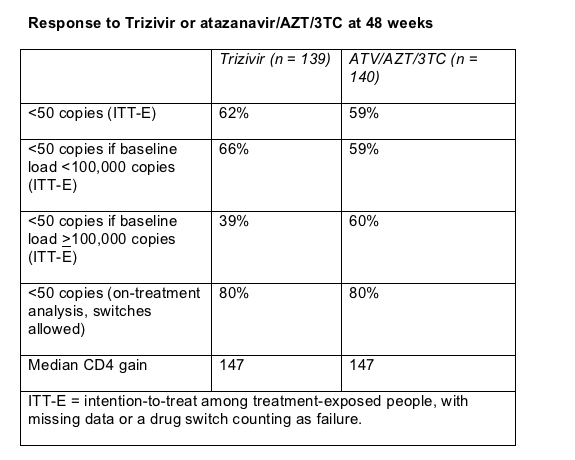 |
 |
 |
| |
Another Look at Three Nukes (Trizivir)--Versus Unboosted Atazanavir
|
| |
| |
46th ICAAC, September 27-30, 2006, San Francisco
Mark Mascolini
September 28, 2006
A 48-week trial of two nonstandard first-line regimens found that one's as good as the other, but whether they're as good as recommended first-line combinations remains uncertain at best [1]. With colleagues in Florida and Texas, Princey Kumar of Georgetown University in Washington, DC, pitted first-line Trizivir (AZT/3TC/abacavir) against 400 mg of unboosted atazanavir plus AZT/3TC in previously untreated people.
After Trizivir failed to match efavirenz-based regimens in AIDS Clinical Trial Group (ACTG) study A5095 [2], guideline writers relegated Trizivir to the "alternative" column as a first-line option. Similarly, unboosted first-line protease inhibitors (PIs) have justly fallen into disuse. Kumar and colleagues advised potential enrollees that neither regimen they planned to use in this open-label trial enjoyed the sanction of guideline authorities.
They recruited 279 people with a viral load below 200,000 copies and at least 100 CD4 cells. The primary endpoint was the percentage of people with a viral load below 50 copies at week 48 in an intent-to-treat analysis in which missing data or a drug change counted as failure. The protocol did allow switches for abacavir hypersensitivity reactions and for two side effects typically attributed to atazanavir--jaundice and scleral icterus.
Median pretreatment CD4 counts stood at 274 in the Trizivir group and 262 in the atazanavir group, while median viral loads measured 4.48 and 4.64 log copies/mL. More than 80% in each study group had a viral load below 100,000 copies when treatment began.
While 103 people (74%) finished 48 weeks of treatment in the Trizivir arm, 98 (70%) did so in the atazanavir/AZT/3TC group. Virologic failure proved the principal cause of failure to complete the study, as detailed below. While 62% randomized to Trizivir had a sub-50-copy load at week 48, 59% randomized to atazanavir/AZT/3TC reached that mark, a result indicating equivalence of the two regimens (Table). Among people taking Trizivir, the response rate proved particularly low among people who started treatment with a load above 100,000 copies.

The study protocol defined failure five ways--as failure to have at least a 1-log (10-fold) drop in viral load by week 12, failure to have a load under 400 copies by week 24, a confirmed load below 50 copies followed by a confirmed load above 400 copies by week 24, a confirmed load above 400 copies at week 24 or later, or a single load above 400 copies at week 48. By those criteria Kumar counted 18 virologic failures (13%) in the Trizivir group (8 [44%] with a baseline load above 100,000 copies) and 17 (12%) in the atazanavir group (5 [29%] with a baseline load above 100,000 copies).
Ten treatment-related mutations emerged in the Trizivir group (nine M184Vs and one thymidine analog mutation) and 11 in the atazanavir group (including nine M184Vs). No major PI mutations cropped up in the atazanavir group.
Grade 3 or 4 hyperbilirubinemia affected 21 people (16%) taking atazanavir and none taking Trizivir. Triglycerides rose 5% in the atazanavir group and 11% in the Trizivir group. "Bad" low-density lipoprotein cholesterol fell 6% with atazanavir and 5% with Trizivir, while "good" high-density lipoprotein cholesterol rose in both groups.
Although Kumar concluded that Trizivir remains a reasonable first-line option for people with a viral load under 100,000 copies, several eminent HIV specialists in the audience, including Paul Volberding of the San Francisco VA and Christine Katlama from the Pitie-Salpetriere Hospital in Paris, disagreed. Session cochair Constance Benson, from the University of California, San Diego, noted that durability has been fragile with triple-nucleoside regimens. Kumar did not have data beyond 48 weeks to allay that concern.
The Trizivir arm of ACTG A5095 got shut down at week 32 of that trial when the review panel saw a 21% virologic failure rate in the triple-nucleoside arm versus 11% in the combined efavirenz arms [2]. In that study time to virologic failure proved significantly faster with Trizivir than with an efavirenz regimen regardless of whether pretreatment viral load was above or below 100,000 copies.
References
1. Kumar PN, Patel P, Salvato P, et al. ACTION study: efficacy and safety of abacavir/lamivudine/zidovudine BID versus lamivudine/zidovudine BID + atazanavir QD in ART-naive HIV-1 infected subjects. 46th ICAAC. September 27-30, 2006, San Francisco. Abstract H-1058.
2. Gulick RM, Ribaudo HJ, Shikuma CM, et al. Triple-nucleoside regimens versus efavirenz-containing regimens for the initial treatment of HIV-1 infection. N Engl J Med 2004;350:1850-1861.
|
| |
|
 |
 |
|
|